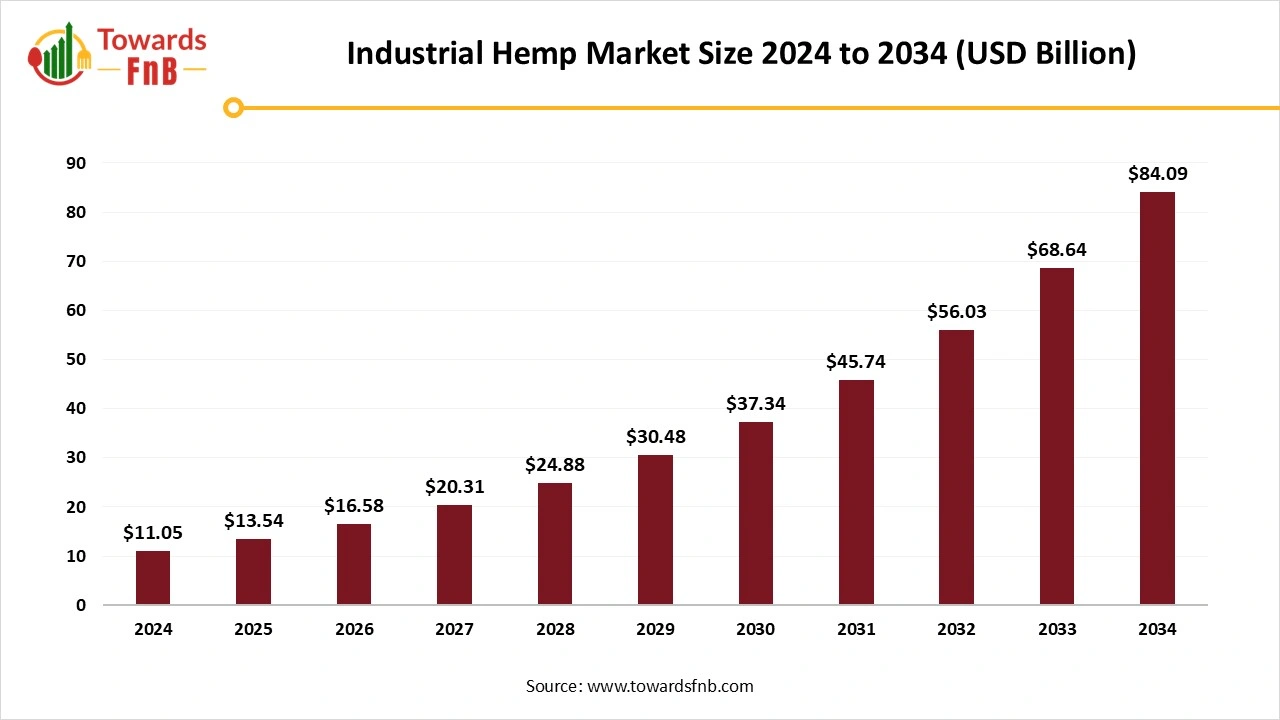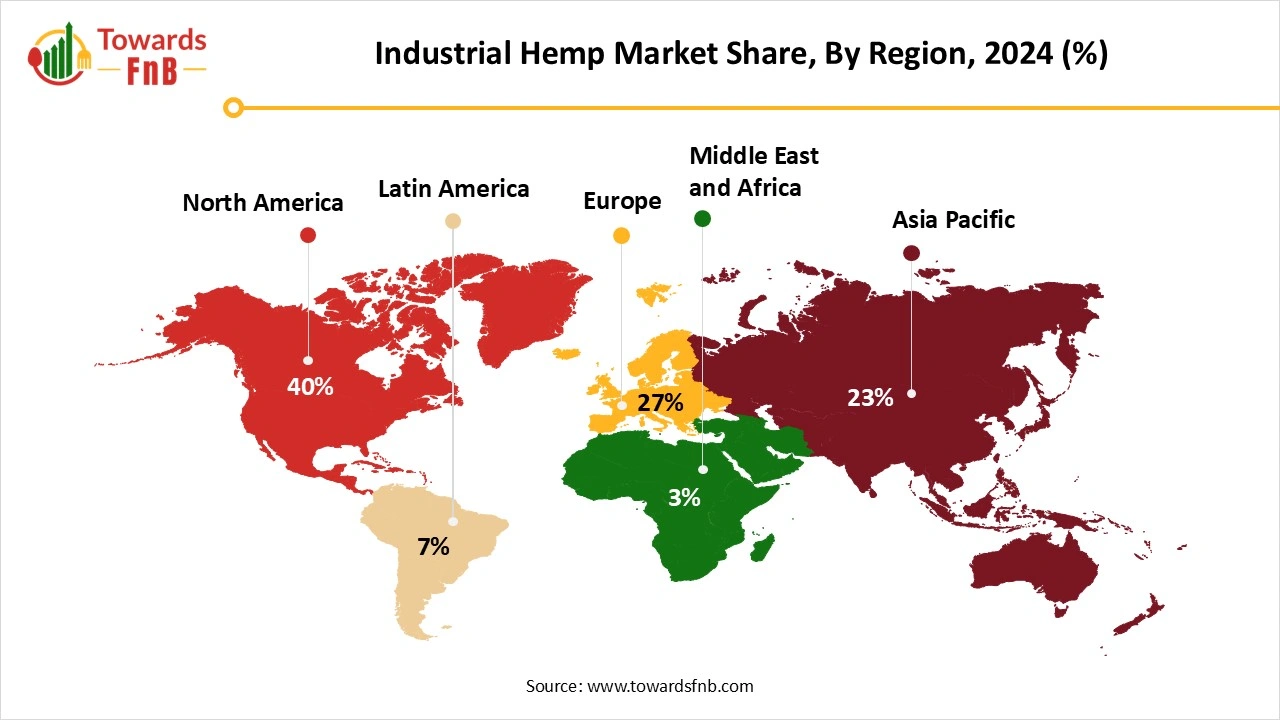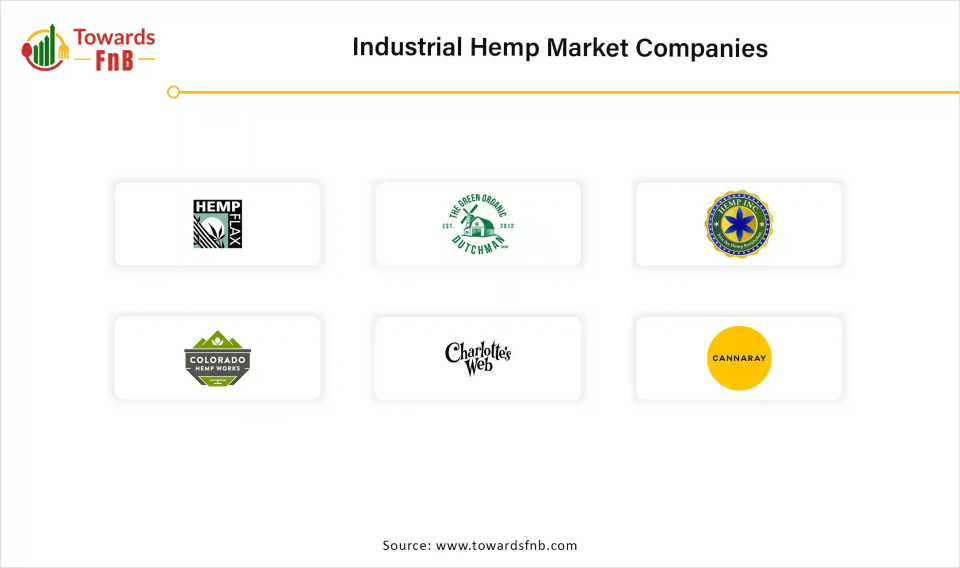November 2025
The global industrial hemp market size calculated at USD 11.05 billion in 2024 and is anticipated to increase from USD 13.54 billion in 2025 to an estimated USD 84.09 billion by 2034, witnessing a CAGR of 22.5% during the forecast period from 2025 to 2034. Significant surge in interest owing to its wide range of applications across textiles, bioplastics, food, and pharmaceuticals.

| Study Coverage | Details |
| Growth Rate from 2025 to 2034 | CAGR of 22.5% |
| Market Size in 2025 | USD 13.54 Billion |
| Market Size in 2026 | USD 16.58 Billion |
| Market Size by 2034 | USD 84.09 Billion |
| Largest Market | North America |
| Base Year | 2024 |
| Forecast Period | 2025 to 2034 |
| Regions Covered | North America, Europe, Asia-Pacific, Latin America, and Middle East & Africa |
The industrial hemp market involves the cultivation, processing, and commercialization of hemp and hemp-based products. Hemp is a Cannabis sativa plant species type which is grown specifically for industrial uses. Industrial hemp is used in diverse sectors such as textiles, automotive, food and beverage, personal care, pharmaceuticals, and construction materials. Unlike marijuana, industrial hemp has low THC (tetrahydrocannabinol) content and is not used for recreational drug purposes.
The market is evolving from niche to mainstream due to rising demand for eco-friendly materials and alternatives to synthetic inputs. From hemp fiber in construction and automotive to hemp seeds in nutrition, the applications are expansive. Legalization in several countries and increasing investment in sustainable agriculture are driving this market forward. Producers are innovating with hemp-derived bioplastics, textiles, and personal care products to tap into conscious consumer bases. Moreover, hemp’s low environmental footprint and rapid growth cycle make it a highly sustainable option. The combination of demand, regulation, and innovation is creating a fertile ground of expansion.
The industrial hemp market is experiencing substantial opportunity driven by the increasing demand for sustainable and eco-friendly products. As consumers become more environmentally conscious, the appeal of hemp as a renewable resource for textiles, bioplastics, and construction materials continues to rise. Legalization and relaxed regulations in various countries have further opened avenues for large-scale cultivation and innovation. Technological advancements in hemp processing and product development have led to an expanded range of applications in diverse sectors. Additionally, the growing interest in wellness and nutraceutical products incorporating hemp extracts is fueling market expansion. Collectively, these factors contribute to a vibrant ecosystem that supports the industrial hemp industry's trajectory toward mainstream acceptance.
Despite its growth potential, the industrial hemp market faces several challenges that could hinder its progress. Regulatory discrepancies between states in the U.S. create inconsistencies in cultivation and distribution, often slowing down market penetration. Additionally, the lack of standardized grading systems for hemp products can lead to quality control issues, affecting consumer trust and market stability. Competition from synthetic alternatives remains a significant barrier, as established industries may resist transitioning to hemp-based solutions. Furthermore, inadequate infrastructure for processing and distribution can limit producers' ability to meet rising demand efficiently. Lastly, educating consumers and businesses about the benefits of hemp over traditional materials requires continuous effort and investment.
How North America Hemp’s Golden Harvest Begins?
North America dominated the industrial hemp market in 2024, driven by progressive policies, strong R&D infrastructure, and a growing consumer shift towards sustainable products. The U.S. farm bill of 2018 legalized hemp cultivation, triggering a wave of investments and large-scale farming operations. Canada with its well-established hemp industry, continues to contribute significantly, especially in the food and fiber segments. The region’s focus on bio-based products and wellness trends has propelled demand for hemp in personal care, nutrition, and textiles. Startups and legacy players alike are capitalizing on opportunities ranging from hempcrete construction to bioplastics. As consumer awareness of hemp’s environmental and economic benefits grows, so does its integration into mainstream markets.

U.S. represents the dominance in North America; In the second wave of market expansion, North America is witnessing a rise in specialized hemp processing units and techniques. The region is also fostering collaborations between agrotech companies and academic institutions to optimize yield and product quality. Demand for hemp-based food and beverages is surging, particularly is surging, particularly among health-conscious millennials and Gen Z consumers. However, market growth is tempered by state-level regulatory discrepancies in the U.S., impacting consistency and sustainability. Still, with increasing support from sustainability-focused investors and innovations in supply chain logistics, North America is positioned to lead the global industrial hemp revolution.
Why Europe is Cultivating a Greener Tomorrow with Hemp?
Europe expects the fastest growth in the market during the forecast period, Countries like France, the Netherlands, and Germany have embraced hemp farming for decades, giving the region a mature and diversified hemp landscape. The industrial hemp market is experiencing significant growth, with projections indicating a rise. This surge is largely due to the increasing applications of hemp across various sectors, including textiles, bioplastics, food, and pharmaceuticals. The dominance of hemp fiber in the market reflects the material's versatility and demand, with textiles holding the largest application share. Additionally, innovations in hemp-derived products are contributing to the expansion of sustainable practices within industries. As legal regulations become more favorable, investment in hemp cultivation and processing is likely to escalate.
In Europe, a mature hemp industry has fostered a diverse market driven by countries with a strong history of hemp farming, such as France and Germany. The demand for eco-friendly products is boosting the cultivation of hemp, particularly for bioplastics and textiles. European consumers are increasingly making sustainable choices, further supporting the rise of hemp in the personal care and wellness sectors. Collaboration between agricultural technologists and traditional farmers is paving the way for more efficient cultivation methods and product quality enhancements. With a focus on environmental sustainability, the European market is actively positioning hemp as a critical resource in addressing climate challenges. This combination of tradition and innovation underscores Europe's commitment to cultivating a greener tomorrow with industrial hemp.
Why is Hemp Fibre Dominating the Industrial Hemp Market in 2024?
The hemp fibre segment dominated the market in 2024, and the demand for sustainable and eco-friendly alternatives is driving companies to substitute synthetic and cotton fiber with hemp. Additionally, its low water requirements and minimal need for pesticides make it a favorite among sustainable materials developers. Hemp fibers' long-standing history in industrial use has enabled better processing technologies and supply chain networks. As environmental regulations tighten, industries are increasingly turning to hemp fiber as a reliable and compliant raw material.
Technological advancements in retting and fiber separation have further enhanced the usability of hemp in high-performance applications. Many manufacturers are now incorporating hemp composites in automotive interiors, footwear, and packaging solutions. With growing consumer consciousness around sustainable fashion, the demand for hemp-based clothing has surged. Furthermore, hemp can create a construction material. Made from hemp fiber and lime is gaining popularity in green buildings. The expanding scope of application ensures hemp fiber retains its leading position in the product type segment. Continued investment in industrial-grade cultivation and processing will solidify its market stronghold in the years ahead.
The Hemp Oil Segment Expects the Fastest Growth in the Industrial Hemp Market During the Forecast Period.
Fueled by rising interest in plant-based wellness and skincare. Extracted from hemp seeds, the oil is rich in essential fatty acids and antioxidants, making it ideal for nutraceutical and cosmetic applications. consumers are gravitating towards hemp oil for its perceived benefits in heart health, inflammation control, and skin hydration. In the beauty industry, hemp oil-infused creams, serums, and shampoos are gaining mainstream appeal. As regulatory acceptance broadens across regions, hemp oil is entering food and beverage formulations as well. The clean-label trend is further pushing demand, particularly in health-focused product categories.
Beyond its nutritional value, hemp oil is being researched for its potential therapeutic benefits in anxiety relief and pain management. It has also become a staple in vegan and keto diets due to its nutrient profile. New product launches and brand extensions using hemp oil are expanding its visibility on retail shelves. E-commerce platforms are playing a pivotal role in boosting awareness and accessibility of hemp oil products. With minimal legal hurdles compared to CBD oil, hemp oil is emerging as a safer and more commercially viable product. This upward trajectory signals robust future growth for this versatile extract.
Why did Textiles Segment Dominated the Industrial Hemp Market in 2024?
The textiles segment dominated the market in 2024. The textile segment of the industrial hemp market is gaining significant traction due to the rising demand for sustainable and eco-friendly materials. Hemp fibers are known for their durability, breathability, and biodegradability, making them an ideal choice for various textile applications. Unlike conventional cotton, hemp requires fewer pesticides and water, thus offering a more sustainable alternative in fashion and home textiles. This shift towards hemp-based textiles aligns with the growing trend of conscious consumerism, where buyers are increasingly prioritizing environmentally responsible products. Brands are exploring innovative designs and blends that incorporate hemp fibers, leading to a resurgence of interest in this age-old material. As sustainability continues to shape consumer preferences, hemp textiles are poised to become a staple in the fabric industry.
In addition to their eco-friendly properties, hemp textiles offer a range of unique characteristics that appeal to manufacturers and consumers alike. The natural resistance to mold and UV rays makes hemp a practical choice for outdoor apparel and gear. Brands are increasingly showcasing hemp in their collections, often promoting the sustainable narrative behind their products. Moreover, the expansion of hemp cultivation is expected to enhance the availability and affordability of hemp fibers, fostering greater adoption in mainstream textile production. Innovations in processing techniques are also improving the softness and versatility of hemp fabrics, making them more competitive against traditional materials. As the textile segment of the hemp market evolves, it presents exciting opportunities for sustainable fashion and responsible consumer choices.
The Biofuels Segment Expects the Fastest Growth in the Market During the Forecast Period.
Driven by global energy transition efforts and carbon reduction mandates. Hemp biomass, especially stalks and leaves, can be converted into ethanol and biodiesel through thermochemical processes. With growing pressure to reduce dependence on fossil fuels, biofuels made from hemp offer a sustainable and low-emission alternative. Countries are exploring hemp as a dual-purpose crop that can be harvested for both industrial use and energy generation. Research institutions and green energy startups are investing in pilot projects for commercial-scale hemp biofuel production. This emerging interest positions hemp as a valuable contributor to the renewable energy matrix.
In rural areas, hemp biofuel could support energy self-sufficiency and generate additional income streams for farmers. The versatility of hemp biomass ensures a consistent raw material supply, especially in regions with rotational farming practices. Its high cellulose content enhances energy yield efficiency, making it comparable to traditional biofuel crops like corn and sugarcane. Hemp-based biofuels also have the advantage of lower land and water usage. As technology matures and commercialization expands, the cost-competitiveness of hemp biofuel is expected to improve. This shift may redefine how hemp is perceived not just as an industrial material, but as a clean energy source.
Why did Hemp Cultivars Segment Dominated the Industrial Hemp Market In 2024?
The hemp cultivars segment dominated the market in 2024, These cultivars are bred for higher yield, pest resistance, and compatibility with mechanized farming. Their predictable performance and compliance with THC limits make them suitable for large-scale agricultural practices. With more regions legalizing hemp cultivation, certified cultivars offer a reliable path to market entry. Agronomic research institutions are continuously developing improved variants to adapt to different climates and soil conditions. These factors collectively drive the demand for single-purpose hemp cultivars across the supply chain.
Additionally, due to progressive policies and a robust R&D infrastructure. Concurrently, Europe is projected to expand rapidly, benefiting from its established hemp cultivation practices and increasing consumer demand for eco-friendly alternatives. The versatility of hemp, from textiles to bioplastics and building materials, makes it an appealing choice for diverse industries. As legalization progresses globally, investments in hemp production are surging, paving the way for innovative applications. Overall, the shift towards sustainability is catalyzing the transformation of hemp from a niche product to a mainstream market player.
The Dual-Purpose Hemp Cultivars Segment Expects the Fastest Growth in the Industrial Hemp Market During the Forecast Period.
This multi-utility approach is gaining traction among small and medium-scale farmers seeking to diversify revenue streams. These cultivars offer flexibility in end-use applications and maximize land utilization, especially in resource-constrained regions. As processing technologies improve, separating fiber and seed components becomes more efficient, reducing post-harvest costs. The dual-purpose model supports circular farming systems and aligns with regenerative agriculture trends. With a single crop cycle delivering two outputs, these cultivars are becoming a smart economic choice.
The industrial hemp market is rapidly evolving, with its value projected to grow significantly over the next decade. North America currently leads the market, holding a substantial share due to favorable regulations and growing consumer demand for sustainable products. Meanwhile, Europe is set to expand at an impressive rate, leveraging its long history of hemp cultivation to foster innovation. Key applications range from textiles to bioplastics, as industries increasingly seek eco-friendly alternatives. The surge in hemp-based products highlights a broader shift towards sustainability, driven by conscious consumer preferences. As the market continues to grow, advancements in processing and cultivation techniques will play a crucial role in shaping the future of hemp across various sectors.
Why did Automotive Segment is Dominated the Industrial Hemp Market in 2024?
The automotive segment dominated the market in 2024, thanks to its lightweight, durable, and environmentally friendly properties. Hemp fibers are increasingly used in interior panels, door inserts, insulation, and even structural components. These composites offer weight reduction, which improves fuel efficiency and lowers emissions, making them ideal for electric and hybrid vehicles. Major automotive manufacturers in Europe and North America are investing in hemp-based materials as part of their green transition. Hemp’s natural shock-absorption and soundproofing properties add to its functional appeal in vehicle design. With rising consumer expectations for eco-conscious cars, hemp is driving a sustainable shift in automotive innovation.
The cost advantages of using locally sourced hemp also contribute to its adoption in auto manufacturing. OEMs are partnering with bio-composite suppliers to co-develop high-performance materials tailored for vehicles. Regulatory pressure to reduce plastic use in cars is further boosting the case for hemp integration. In electric vehicles (EVs), where weight is critical for battery efficiency, hemp composites are offering tangible benefits. Additionally, the use of hemp aligns with ESG goals and helps automakers enhance brand reputation. The trend is not just a novelty; it signals a long-term structural change in how vehicles are designed and built.
The Construction Segment Expects the Fastest Growth in the Industrial Hemp Market During the Forecast Period.
propelled by the rising demand for sustainable building materials. Hempcrete a mix of hemp hurds, lime, and water is gaining attention for its insulation, carbon sequestration, and breathability properties. Eco-builders and architects are embracing hempcrete for residential and commercial projects, especially in Europe and North America. Hemp fibers are also used in thermal and acoustic insulation panels, contributing to energy-efficient buildings. As urbanization increases, green construction materials like hemp are expected to play a critical role in reducing carbon footprints. Governments and municipalities are incentivizing low-impact construction, giving hemp a strong tailwind.
The fast adoption of hemp in construction is also fueled by its rapid renewability and low embodied energy. Hemp buildings have a negative carbon footprint, capturing more CO₂ than they emit during production. Builders appreciate hempcrete for being fire-resistant, pest-resistant, and long-lasting. Pre-fabricated hemp blocks and panels are making it easier to scale construction projects. The growing awareness of indoor air quality is another factor driving the demand for non-toxic building materials like hemp. As the industry shifts toward net-zero and circular models, hemp’s role in construction is set to expand significantly.
EcoTechnilin

By Product Type
By Application
By Source
By End-Use Industry
By Region
The global ready-to-eat food packaging market size is set for steady growth increasing from USD 95.17 billion in 2025 to USD 164.92 billion by 2034, w...
The global food waste management market size is forecasted to reach from USD 81.78 billion in 2025 to USD 132.17 billion by 2034, expanding at a CAGR ...
November 2025
November 2025
November 2025
November 2025